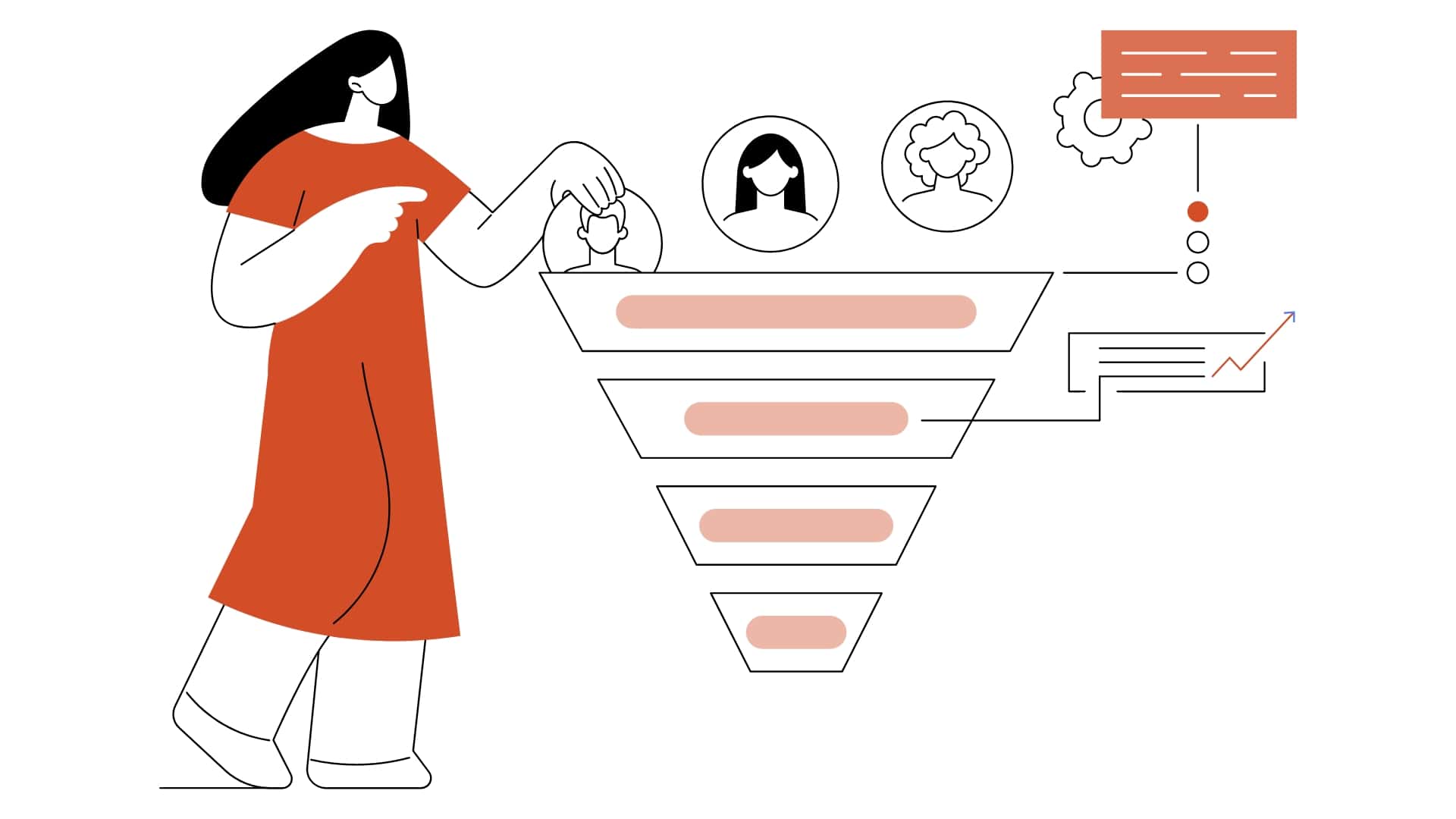How to Nail Lead Nurturing and Get Prospects to Buy Sooner
Unless your product is sold exclusively at the checkout counter where a customer will be introduced to it and then immediately decide whether to buy it, lead nurturing is important to your business. Lead nurturing is what helps move prospects through the sales funnel and ultimately decide to buy from you.
The good news/bad news is that a lot of companies drop the ball during the lead nurturing phase. Do it right, and you can increase market share by being there to support your prospects’ needs during this often-overlooked chapter.
What is the sales funnel? What is lead nurturing?
Think about the basic sales funnel. There are many different models you can use, but in general, the first step is lead generation (identifying prospects), which is when you’ll use top-of-funnel marketing strategies. At the bottom of the funnel, the lead/prospect makes a purchase (or decides not to purchase anything). Lead nurturing is what you can—and absolutely should—do along the way to help guide prospects toward purchasing a product and, more specifically, your product.
Lead nurturing is a marketing strategy in which you help your prospects recognize their problem and educate them on the solutions available to solve their problem, eventually leading them to (hopefully) select your product as their solution. Depending on your product, the market and your sales cycle (how long it takes for a prospect to decide to buy), lead nurturing campaigns contain multiple touchpoints and a mix of content types—and can last weeks, months or even years.
For example, in the consumer space, a middle-income buyer might take a week or two between becoming interested in a smartwatch and deciding which one to purchase, but it might take that same consumer months to decide they want a new refrigerator and which model to buy. Similarly, in the B2B world, purchasers might take a week or two to determine what type of fridge to purchase for their office’s new break room but years to change to a new telecommunications system.

Lead nurturing is what you can—and absolutely should—do along the way to help guide prospects toward purchasing a product and, more specifically, your product.
Why is lead nurturing important?
Lead nurturing is important for three primary reasons:
- It takes multiple exposures before a buyer chooses a vendor or product.
- Long buying cycles can work against you if buyers forget you exist.
- In increasingly commoditized industries, you need to stay visible to make the shortlist.
Sales cycles can be long, especially in the B2B market, and you don’t want potential customers to forget about you by the time they finally go to buy. Consider this scenario:
Joe decides he is sick of his sedan. One of Joe’s friends just got a Toyota SUV, while another bought a Honda. Both are quite happy. Joe decides he’s going to sell his car and buy an SUV when he gets his tax refund.
The friend who bought the Honda mentioned to Joe how much she loves it a couple of times in the beginning but hasn’t brought it up since. The friend with the Toyota, however, tells Joe weekly about all the great features his SUV has, invites Joe to sit in it and even offers to let Joe use it to pick up a play kitchen Joe found for his kids.
Which vehicle is Joe more likely to select for himself? Probably the Toyota, right? That’s the magic of lead nurturing. It keeps your business/product top of mind when a consumer goes to pull the trigger on making a purchase. But more than that, it educates prospects on what they need to know to solve their problem (ideally with your product).
In some cases, lead nurturing can even help move a consumer through the buying process faster and make a purchase decision sooner. Sophisticated, well-thought-out lead nurturing campaigns serve up all the right content at just the right times, helping consumers navigate each phase of the buying process with ease.

Sales cycles can be long, especially in the B2B market, and you don’t want potential customers to forget about you by the time they finally go to buy.
Who is responsible for lead nurturing?
Lead nurturing is typically led by the product marketing manager, with assistance and direction from the rest of the product team. Sales, account management and product stakeholders can all share their specialized knowledge to help you better understand your typical buyer’s approach and speed up the sales process.
For instance, you might want to start by asking:
- How do customers typically buy your solutions? How long are their buying cycles?
- What common objections do you hear? Which ones are hardest to address?
- What makes your solution(s) unique and excel compared to your competition?
With these data points, you can then build a lead nurturing campaign tailored expressly to your market and segments with the right mix of content, frequency and calls to action to take them from lead to buyer.
When should lead nurturing happen?
Like most marketing activities, lead nurturing isn’t an isolated exercise. It’s a marathon, not a sprint. It’s different from other types of marketing in that it’s tailored to the prospect’s individual timeline rather than product launches, company news and other types of events that broader marketing campaigns often are centered around. With lead nurturing, you have to be present and committed to staying visible throughout the sales funnel/buying process, and you must align with the buyer’s journey and engagement level.
Your lead nurturing campaign should begin as soon as a lead is generated and continue all the way through the final purchasing decision and perhaps even beyond. Because the campaign is triggered by the lead and tailored to his or her position in the sales funnel, there’s no specific time of day, month or year to begin or end.
How to nail lead nurturing
As previously mentioned, there’s no one-size-fits-all formula to a successful lead nurturing campaign. It is a balancing act that relies on science, art and a bit of guesswork. You can build the perfect lead nurturing campaign for your sales funnel by following these principles:
Make it all about the customer
The point of lead nurturing is to stay visible until your leads are ready to buy. But to be effective, they must believe you can help them, and there’s no better way to do this than by keeping your content customer-focused. Whatever the format, aim to educate and entertain—and make it easy for them to take the next step.
- Review your buyer personas annually. Do they still match your intended audience, or do you need to create new personas to target a new market segment?
- Personalize your messages by segmenting your lists. As you learn more about your prospects, find opportunities to add value and keep connected in relevant, meaningful ways.
- Ask questions. What are their challenges, needs and interests? The more you know, the more consumable you’ll make your webinars, white papers, blog posts or infographics.
- Ask who else should be added to your distribution list. This will bring members of your leads’ buying committee into the loop.
Be consistent
Every missed blog post or e-newsletter deadline that passes is a missed opportunity to connect with your audience and get closer to making the shortlist. How can you make it easier to build consistency and get more exposure?
- Use an editorial calendar. For some, rigidity can be painful. But relying on your own will probably won’t last long, and despite your best intentions, you may end up overwhelmed into inaction. So use a calendar, make it as simple as possible and stick to it.
- Worried you won’t follow the calendar? Spread this responsibility by assigning deliverables to different stakeholders. Your combined efforts will keep everyone accountable and in the loop.
Use a style guide to help you write faster and with a single voice. - Create an internal content repository your organization can access anytime. This way, sales can easily retrieve and forward valuable information to their leads on demand.
Keep it simple
If you want to keep your readers’ attention and your content mojo intact, keep it simple. Never waste their time. Know your audience, focus your message and be sure you include a call to action.
- Industry jargon is for geeks. Sure, you might be selling a SaaS e-commerce platform or deploying mission-critical data systems, but the VP of e-commerce and the CTO you’re writing for are still human. In an increasingly noisy world where everyone’s attention is eroding, there’s no room for heavy verbiage. Write conversationally, as if you were chatting with them over a cup of coffee.
- Focus on a single message. What is it you want your reader to know?
- Always have a call to action. Do you want them to call you? Download your latest white paper? Get feedback about your case study? No matter where your reader is in the sales cycle, a call to action keeps the line of communication open and gently pushes your lead to the next step.
- Repurpose your content whenever you can. It not only saves you time but also stretches your marketing dollars to increase your ROI. For example, expand a blog post into a two-page white paper; reformat your ebook copy into a webinar script; turn your latest customer testimonial into a full-fledged case study.
Build complexity slowly
As you learn more about your leads, you’ll uncover opportunities to fine-tune your messages and quicken the conversion process. Remember, building a successful email campaign is a strategic, long-term effort.
- Segment your list as you learn more about your leads. From basic information such as job title, responsibilities and company size, to the intricacies of their pain points and challenges, you’ll find the sweet spot that resonates with them and can focus on that in future messages.
- Automate drip campaigns. Sending timed emails ensures you don’t neglect your audience and can help you segment them into different branches.
- Vary your communication methods. Although lead nurturing is primarily done by email, physical mail is an unclogged channel that can be very effective at the beginning of a campaign. People respond to different actions, so don’t be afraid to experiment with direct mail and short voicemails.
- Invest in robust CRM resources to streamline your efforts and stay on top of all communications with your leads.
- Ask for help. The size and scope of your program is unique; sometimes it makes sense to enlist an outside resource to help evaluate progress and plan your next move.
Lead nurturing is a must for B2B marketers, but no single generic plan will appeal to the masses. To get the most from your campaigns, be willing to test, retest, evaluate and optimize. It might sound tedious, but once you’ve found a winning combination, all that’s left is to rinse and repeat the steps for that particular segment.
When you master these tips for nurturing your hard-earned leads, your leads will feel like they matter. And once they do, you’ll convert them into happy customers for life.
Examples of lead nurturing campaigns
Lead nurturing campaigns should be designed strategically to guide prospects through the buying process. Depending on your product and sales funnel, they can range in complexity from simple to sophisticated.
For example, let’s say you’re selling refrigerators and your market takes an average of six weeks to make a purchasing decision. A simple lead nurturing email campaign may look something like this:
Day 1 trigger: Prospect provides email address in a sweepstakes to win a kitchen makeover.
Day 1 email: “Thank you for entering!”
Week 2 email: “5 simple ways to update your kitchen before the weekend”
Week 3 email: “Download a free appliance-buying guide”
Week 4 email: “7 features you need in your next fridge”
Week 5 email: “See how our fridge would look in your kitchen”
Week 6 email: “Weekend sales event!”
This type of lead nurturing campaign is time-based, and the strategy is simply to remain in front of the prospect until they make a purchase. Hopefully your product will be the first thing they think of when they decide to buy. This can work for some businesses that don’t have much competition.
A more sophisticated campaign would be action dependent, in which you’d design each touch to coincide with what the prospect does. For example, based on the above, the first action would look more like this:
Day 1 trigger: Prospect provides email address in a sweepstakes to win a kitchen makeover.
Day 1 email: “Thank you for entering!”
If email is opened, second email would be sent on Day 2.
If not opened, second email would be a coupon sent on Day 3.
Then, there might be different emails, depending on whether the prospect opens the second email, opens and clicks in the second email or does not open the second email. This process would repeat at each stage, (hopefully) providing the prospect with the exact right content at the right time during their decision-making journey.
The freemium strategy
One sales model that’s often considered to be the ultimate lead nurturing campaign is the freemium model in which you grant prospects access to a portion of your product or a free trial with the goal of them purchasing once they use it. Dropbox has nailed the freemium model:
Dropbox drives prospects directly to their product and nurtures them until they are ready to buy. When prospects approach a certain percentage of the available storage on their freemium product, Dropbox notifies them via the desktop app and email. Using this strategy, Dropbox has reached a $1 billion revenue run rate faster than any other company.
Learn more about lead nurturing
Lead nurturing is what helps move prospects through the sales funnel and ultimately decide to buy from you. Learn how to nail lead nurturing in Pragmatic Institute’s Market course today.




